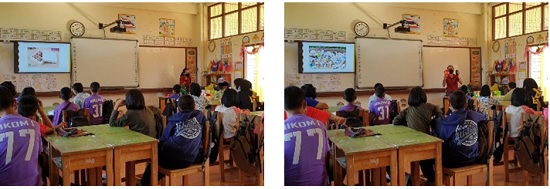INQUIRY-BASED STEM LEARNING TO ENHANCE MATHEMATICAL CREATIVE THINKING ON THREE-DIMENSIONAL GEOMETRIC FIGURES FOR GRADE 6 STUDENTS
DOI:
https://doi.org/10.14456/nrru-rdi.2023.11Keywords:
STEM Education, Mathematical Creative Thinking, Three-Dimensional geometric figuresAbstract
Inquiry-based stem learning that inspire creativity in the research's participants. The objectives were to research the principles and effects of inquiry-based instruction based on the STEM education method that promotes mathematical creativity in Pathomsuksa 6 students' understanding of three-dimensional geometry. The target group comprised 18 Pathomsuksa 6 learners in a specific target group who took part in a lesson plan based on STEM education, learning reflection, activity sheets, workpieces, and cutting-edge tests that have been approved by three experts. The data was collected through workshops that took place in the classroom for 16 hours. using statistics to compute percentages and content analysis, triangulation, and data analysis to analyze the data. The results indicated that directions for inquiry-based instruction built on STEM education were beneficial for assisting instructors in developing challenging real-life scenarios that were combined with STEM education. The circumstances in which resources should be used to achieve the best possible student work are chosen by the teacher. According to the results of the study on mathematical creativity, the majority of students were able to increase their creativity in the development of unique ideas, the production of a variety of concepts, and the assessment and improvement of concepts, respectively. Having more creativity skills of students.
References
Kemmis, S. &McTaggart, R. (1998). The Action Research Planner. Australia : Deakin University Press.
Kirici, M.G. & Bakirci, H. (2021). The effect of STEM supported research-inquiry-based learning approach on the scientific creativity of 7th grade student. Journal of pedagogical reserch, 5(2). 19-35.
Leelasornchai, A., Panawong, C., & Kaewurai, W. (2018). The development of mathematics project-based learning activities based on stem education to enhance creative thinking and learning achievement on “Probability” for grade 9th students. Journal of Graduates Studies in Northern Rajabhat Universities, 8(14), 165-182. (In Thai)
MacDonald, A., Danaia, L., Sikder, S., & Huser, C. (2021). Early childhood educators’ beliefs and confidence regarding STEM education. International Journal of Early Childhood, 53, 241-259. https://doi.org/10.1007/s13158-021-00295-7
Ministry of Educaiton Thailand. (2008). Basic Education Care Curriculum B. E. 2551 (A. D. 2008). Bangkok : The Agricultural Cooperative Federation of Thailand. (In Thai)
Murphy, S., MacDonald, A., Danaia, L., & Wang, C. (2019). An analysis of Australian STEM education strategies. Policy Futures in Education, 17(2), 122-139. https://doi.org/10.1177/147821031877419
National Institute of Educational Testing Service (Public Organization). (2021). Basic statistics at the provincial level of grade 6 O-NET test results classified by subject matter. Retrieved March 13, 2022, from https://catalog.niets.or.th/dataset/it-16-30/resource/ddfb8dbd-4ee8-40b6-bfec-87ce3d9109a8
Ong, E., Luo, X., Yuan, J., & Yingprayoon, J. (2020). The effectiveness of a professional development program on the use of stem-based 5e inquiry learning model for science teachers in China. Science Education International, 31(2), 179-184.
Onsee, P. (2019). Development of Critical Thinking Skill and Academic Achievement in Physics of Mathayomsuksa 4 Student Using Inquiry-Based Learning with STEM Education. Thesis, Master of Education Program in Teaching of Science and Mathematics, Mahasarakham University, Mahasarakham. (in Thai)
Pholphak, W. (2018). The results of learning activities by using creative processes on learning achievement and mathematical creativity on “surface area and volume” of matheyomsuksa 3 students. Thesis, Master of Science Program in Mathematics study, Silpakorn University, Bangkok. (in Thai)
Phumkokrak, S., & Kittisuntorn, C. (2019). A Study of mathematics learning outcomes and creativity of ninth graders using stem education. Ratchaphruek Journal, 17(2), 73-79. (In Thai)
The Institute for the promotion of teaching science and technology. (2017). Using engineering design process to enhance creative thinking and problem solving. IPST Magazine, 46(209), 23-27.
The Organization for Economic Co-operation and Development (OECD). (2019). PISA 2021 Creative thinking framework (third draft). Paris : The Organization for Co-operation and Development.
Tytler, R., Williams, G., Hobbs, L., & Anderson, J. (2019). Challenges and opportunities for a STEM interdisciplinary agenda. In B. Doig, J. Williams, D. Swanson, R. Borromeo Ferri, & P. Drake (Eds.), Interdisciplinary mathematics education: State of the art and beyond (pp. 51–84). USA : Springer Press. https://doi.org/10.1007/978-3-030-11066-6_5
Wangsila, P., Supap, W., & Klineam, C. (2018). The study of using mathematical modelling to enhance mathematical creative thinking in geometric analysis topis for 10th grade students. Journal of Education Naresuan University, 22(3), 150-163. (In Thai)

Downloads
Published
How to Cite
Issue
Section
License

This work is licensed under a Creative Commons Attribution-NonCommercial-NoDerivatives 4.0 International License.



